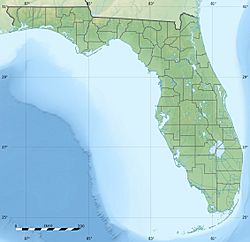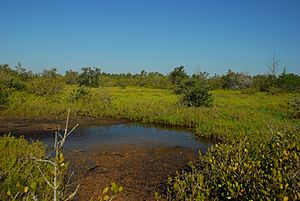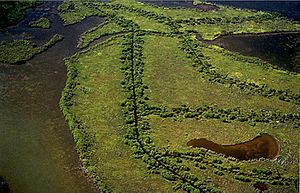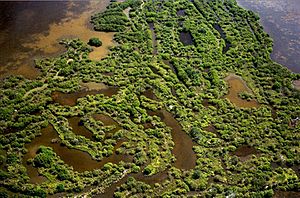Thousand Islands (Cocoa Beach) facts for kids

Native salt marsh mangrove plant growth.
|
|
| Geography | |
|---|---|
| Location | North Atlantic |
| Coordinates | 28°19′22″N 80°37′41″W / 28.3227845°N 80.6281073°W |
| Total islands | ~100 |
| Administration | |
| County | Brevard County |
The Thousand Islands are a special group of islands located in the Banana River Lagoon, near Cocoa Beach, Florida. These islands are a mix of natural land, areas changed by people, and "spoil" islands. Spoil islands are created from dirt and sand dug up during construction.
From the late 1950s to the early 1970s, the islands were changed quite a bit. This happened as more people moved to Brevard County because of the space program at Cape Canaveral and Kennedy Space Center. People reshaped the islands for building and to help control mosquitoes.
Contents
History of the Islands
The State of Florida bought the Thousand Islands in 1988. A few years later, in 1991, the state leased them back to the City of Cocoa Beach. The agreement was that the islands would be used for fun activities and for protecting nature.
The total cost to buy the islands was over $3.2 million. The City of Cocoa Beach, Brevard County, and the State of Florida all helped pay for them.
How the Islands Were Formed
Scientists have studied the ground under the Thousand Islands. They found that the islands were formed when a big storm pushed the sea through a barrier island. This created a large area of sand and dirt, about 900 acres in size.
We don't know exactly when this storm happened. Old maps from the 1800s don't show the Thousand Islands clearly. However, this might just mean the maps weren't detailed enough. Later maps and aerial photos from the 1950s show the area looking much like it does today.
There are about 100 islands in this group. But the exact number can change! When it rains a lot in the summer, the water levels rise. This can make one large island look like many smaller ones.
The Thousand Islands are split into two main parts by the Minutemen Causeway. The whole area covers about 900 acres. It includes salt marshes, mangrove forests, and higher land with different plants.
In the late 1950s, small ditches were dug through the islands. This was done to help water move around and allow fish to reach inner areas. It was also a way to control mosquitoes.
Around the same time, people started digging canals in Cocoa Beach to build houses. They used the dug-up dirt to create new land for homes. Some parts of the Thousand Islands were filled in but never fully built on. This left large areas of higher ground.
Later, in the 1960s, Brevard County Mosquito Control started digging more in the southern part of the islands. This changed some of the salt marsh into higher land.
Plants of the Thousand Islands
The Thousand Islands are home to many different kinds of plants.
Wetland Plants
The wet areas, like the salt marshes, have many mangrove trees. These include red, black, and white mangroves. These trees are very important for the ecosystem.
Other plants found in the wet marshy areas include saltwort, annual glasswort, perennial glasswort, sea blight, and shoreline seapurslane.
Transition Zone Plants
Where the wet salt marsh meets the higher, drier land, you'll find plants like bushy seaside oxeye and buttonwood. If there's a lot of grass, you might see saltgrass and seashore paspalum.
Upland Plants
The higher parts of the islands have different native plants. These include Florida swamp privet, salt bush, cabbage palm, wax myrtle, and strangler fig.
Invasive Plants
Unfortunately, some plants that are not native to Florida have also grown here. These are called "invasive" plants because they can take over and harm the native plant communities. Some examples are Brazilian pepper, Australian pines, and carrotwood. These plants can change how the natural areas work.
There are also old shell mounds in four main areas of the Thousand Islands. These mounds were left behind by people who lived here long ago, before Christopher Columbus arrived.
Protecting and Restoring the Islands
The State of Florida and Cocoa Beach bought the northern islands in 1988 to protect them. The rest of the islands to the south were bought by 2007. These islands are now managed as the Thousand Islands Conservation Area. This is done by the Brevard County Environmentally Endangered Lands Program (EEL).
One big part of protecting the islands is removing the invasive plants like Brazilian pepper and Australian pine. Even though Australian pines are harmful to the environment, some people don't like to see them removed.
After removing these invasive trees, new native plants are sometimes planted. However, it seems that native plants often grow back on their own even faster than the ones that are planted. The plan for managing the northern Thousand Islands is still being updated.
See also
 In Spanish: Mil Islas (Cocoa Beach) para niños
In Spanish: Mil Islas (Cocoa Beach) para niños







